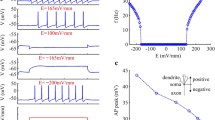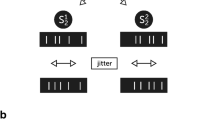Abstract
An externally-applied electric field can polarize a neuron, especially a neuron with elongated dendrites, and thus modify its excitability. Here we use a computational model to examine, predict, and explain these effects. We use a two-compartment Pinsky-Rinzel model neuron polarized by an electric potential difference imposed between its compartments, and we apply an injected ramp current. We vary three model parameters: the magnitude of the applied potential difference, the extracellular potassium concentration, and the rate of current injection. A study of the Time-To-First-Spike (TTFS) as a function of polarization leads to the identification of three regions of polarization strength that have different effects. In the weak region, the TTFS increases linearly with polarization. In the intermediate region, the TTFS increases either sub- or super-linearly, depending on the current injection rate and the extracellular potassium concentration. In the strong region, the TTFS decreases. Our results in the weak and strong region are consistent with experimental observations, and in the intermediate region, we predict novel effects that depend on experimentally-accessible parameters. We find that active channels in the dendrite play a key role in these effects. Our qualitative results were found to be robust over a wide range of inter-compartment conductances and the ratio of somatic to dendritic membrane areas. In addition, we discuss preliminary results where synaptic inputs replace the ramp injection protocol. The insights and conclusions were found to extend from our polarized PR model to a polarized PR model with I h dendritic currents. Finally, we discuss the degree to which our results may be generalized.





















Similar content being viewed by others
Notes
Traub et al. (1991) presents an abstract model of intracellular calcium where each compartment’s rate of absorption can be varied by varying the thickness of an imagined sub-cellular membrane. This coefficient was fine-tuned to best match experimental data.
R 2≡ 1- (sum square of residuals)/ (sum square of differences of the dependent variable from the mean).
The rate of change of the somatic and dendritic membrane potentials are appreciably different only in a 1-2 millisecond period after the TTFS and during an action potential.
References
Barreto, E., & Cressman, J. (2011). Ion concentration dynamics as a mechanism for neuronal bursting. Journal of Biological Physics, 37(3), 361–373. doi:10.1007/s10867-010-9212-6.
Berzhanskaya, J., Gorchetchnikov, A., & Schiff, S.J. (2007). Switching between gamma and theta: Dynamic network control using subthreshold electric fields. Neurocomputing, 70(10-12), 2091–2095. doi:10.1016/j.neucom.2006.10.124, http://www.sciencedirect.com/science/article/B6V10-4M9Y1V1-G/2/05a532a351f790864e8ff5511052b9c3, computational,neural circuitry.
Bikson, M., & Rahman, A. (2013). Origins of specificity during tDCS: anatomical, activity-selective, and input-bias mechanisms. Frontiers in Human Neuroscience, 7, 688. doi:10.3389/fnhum.2013.00688.
Bikson, M., Inoue, M., Akiyama, H., DJ, K., Fox, J., Miyakawa, H., & Jefferys, J. (2004). Effects of uniform extracellular dc electric fields on excitability in rat hippocampal slices in vitro. Journal of Physiology, 557(1), 175–190.
Binder, D., Yao, X., Zador, Z., Sick, T., Verkman, A., & Manley, G. (2006). Increased seizure duration and slowed potassium kinetics in mice lacking aquaporin-4 water channels. GLIA, 53(6), 631–636. doi:10.1002/glia.20315.
Bose, A., & Booth, V. (2004). Bursting in 2-compartment neurons: A case study of the Pinsky-Rinzel model. Center for Applied Mathematics and Statistics.
Cressman, J., John, R., Ullah, G., Ziburkus, J., Schiff, S., & Barreto, E. (2009). The influence of sodium and potassium dynamics on excitability, seizures, and the stability of persistent states: I. single neuron dynamics. Journal of Computational Neuroscience, 26(2), 159–170. doi:10.1007/s10827-008-0132-4.
Cressman, J., Ullah, G., Ziburkus, J., Schiff, S., & Barreto, E. (2011). Erratum to: The influence of sodium and potassium dynamics on excitability, seizures, and the stability of persistent states: I. single neuron dynamics. Journal of Computational Neuroscience, 30(3), 781–781. doi:10.1007/s10827-011-0333-0.
Csicsvari, J., Jamieson, B., Wise, K., & Buzsaki, G. (2003). Mechanisms of gamma oscillations in the hippocampus of the behaving rat. Neuron, 37(2), 311–322. doi:10.1016/S0896-627302)01169-8.
Deans, J.K., Powell, A.D., & Jefferys, J.G.R. (2007). Sensitivity of coherent oscillations in rat hippocampus to ac electric fields. Journal Of Physiology-London, 583(2), 555–565. doi:10.1113/jphysiol.2007.137711.
Dietzel, I., Heinemann, U., & Lux, H. (1989). Relations between slow extracellular potential changes, glial potassium buffering, and electrolyte and cellular-volume changes during neuronal hyperactivity in cat brain. Glia, 2(1), 25–44. doi:10.1002/glia.440020104.
Dyhrfjeld-Johnsen, J., Morgan, R.J., & Soltesz, I. (2009). Double trouble? Potential for hyperexcitability following both channelopathic up- and downregulation of i(h) in epilepsy. Frontiers in neuroscience.
Francis, J.T., Gluckman, B.J., & Schiff, S.J. (2003). Sensitivity of neurons to weak electric fields. The Journal of Neuroscience, 23(19), 7255–7261. http://www.jneurosci.org/cgi/reprint/23/19/7255.pdf.
Gasparini, S., & DiFrancesco, D. (1999). Action of serotonin on the hyperpolarization-activated cation current (I-h) in rat CA1 hippocampal neurons. European Journal of Neuroscience.
Ghai, R., Bikson, M., & Durand, D. (2000). Effects of applied electric fields on low-calcium epileptiform activity in the ca1 region of rat hippocampal slices. Journal Of Neurophysiology, 84(1), 274–280.
Gluckman, B.J., Neel, E.J., Netoff, T.I., Ditto, W.L., Spano, M.L., & Schiff, S.J. (1996). Electric field suppression of epileptiform activity in hippocampal slices. Journal of Neurophysiology, 76(6), 4202–4205. http://jn.physiology.org/cgi/content/abstract/76/6/4202, http://jn.physiology.org/cgi/reprint/76/6/4202.pdf.
Gluckman, B.J., So, P., Netoff, T.I., Spano, M.L., & Schiff, S.J. (1998). Stochastic resonance in mammalian neuronal networks. Chaos: An Interdisciplinary Journal of Nonlinear Science, 8(3), 588–598. doi:10.1063/1.166340, http://link.aip.org/link/?CHA/8/588/1.
Gluckman, B.J., Nguyen, H., Weinstein, S.L., & Schiff, S.J. (2001). Adaptive electric field control of epileptic seizures. Journal of Neuroscience, 21(2), 590–600. http://www.jneurosci.org/cgi/reprint/21/2/590.pdf.
Golding, T.K.Y.K.W.S.N., & Mickus, N.L. (2005). Factors mediating powerful voltage attenuation along ca1 pyramidal neuron dendrites. Journal of Physiology-London.
Han, C.L., Hu, W., Stead, M., Zhang, T., Zhang, J.G., Worrell, G.A., & Meng, F.G. (2014). Electrical stimulation of hippocampus for the treatment of refractory temporal lobe epilepsy. Brain Research Bulletin, 109(0), 13–21. doi:10.1016/j.brainresbull.2014.08.007, http://www.sciencedirect.com/science/article/pii/S0361923014001336.
Holt, G.R., & Koch, C. (1999). Electrical interactions via the extracellular potential near cell bodies. Journal of Computational Neuroscience, 6(2), 169–184. http://www.springerlink.com.mutex.gmu.edu/content/u262m146864wu008/fulltext.pdf.
Janigro, D. (2006). Brain water and ion fluxes: a hard-to-die hypothesis to explain seizure. Epilepsy Currents.
Lippert, A., & Booth, V. (2009). Understanding effects on excitability of simulated I (h) modulation in simple neuronal models. Biological Cybernetics.
McNamara, J. (1994). Cellular and molecular basis of epilepsy. The Journal of Neuroscience, 14(6), 3413–3425. http://www.jneurosci.org, http://www.jneurosci.org/cgi/reprint/14/6/3413.pdf.
Mikkelsen, R., Andreasen, M., & Nedergaard, S. (2013). Suppression of epileptiform activity by a single short-duration electric field in rat hippocampus in vitro. Journal of Neurophysiology, 109(11), 2720–2731. doi:10.1152/jn.00887.2012.
Miranda, P.C., Lomarev, M., & Hallett, M. (2006). Modeling the current distribution during transcranial direct current stimulation. Clinical Neurophysiology, 117(7), 1623–1629. doi:10.1016/j.clinph.2006.04.009, http://www.sciencedirect.com/science/article/pii/S1388245706001726.
Moody, W.J., Futamachi, K.J., & Prince, D.A. (1974). Extracellular potassium activity during epileptogenesis. Experimental Neurology, 42(2), 248–263. doi:10.1016/0014-488674)90023-5, http://www.sciencedirect.com/science/article/B6WFG-4BJW0K8-S5/2/5a1576e44b031b336a2de8069c9f4a03.
Park, E.H., So, P., Barreto, E., Gluckman, B., & Schiff, S. (2003). Electric field modulation of synchronization in neuronal networks. Neurocomputing, 52–54, 169–175. http://www.sciencedirect.com/science/article/B6V10-47T2GNT-K/2/5e5a42a4855dfd83da36607af3a75b8e.
Park, E.H., Barreto, E., Gluckman, B.J., Schiff, S.J., & So, P. (2005). A model of the effects of applied electric fields on neuronal synchronization. Journal of Computational Neuroscience, 19, 53–70. http://www.springerlink.com/content/w1681302gth46592.
Pinsky, P.F., & Rinzel, J. (1994). Intrinsic and network rhythmogenesis in a reduced traub model for ca3 neurons. Journal of Computational Neuroscience, 1(1–2), 39–60.
Pucihar, G., Miklavcic, D., & Kotnik, T. (2009). A time-dependent numerical model of transmembrane voltage inducement and electroporation of irregularly shaped cells. IEEE Transactions on Biomedical Engineering, 56(5), 1491–1501. doi:10.1109/TBME.2009.2014244.
Radman, T., Su, Y., An, J.H., Parra, L.C., & Bikson, M. (2007). Spike timing amplifies the effect of electric fields on neurons: Implication for endogenous field effects. The Journal of Neuroscience, 27, 3030–3036.
Radman, T., Ramos, R.L., Brumberg, J.C., & Bikson, M. (2009). Role of cortical cell type and morphology in subthreshold and suprathreshold uniform electric field stimulation in vitro. Brain Stimulation, 2, 215–228. experimental and Theoretic polarization of neuron.
Reato, D., Rahman, A., Bikson, M., & Parra, L.C. (2010). Low-intensity electrical stimulation affects network dynamics by modulating population rate and spike timing. The Journal of Neuroscience, 30(45), 15,067–15,079. doi:10.1523/JNEUROSCI.2059-10.2010, http://www.jneurosci.org/cgi/content/abstract/30/45/15067.
Richardson, K.A., Gluckman, B.J., Weinstein, S.L., Glosch, C.E., Moon, J.B., Gwinn, R.P., Gale, K., & Schiff, S.J. (2003). In vivo modulation of hippocampal epileptiform activity with radial electric fields. Epilepsia Series 4, 44(6), 768–777. http://search.ebscohost.com/login.aspx?direct=true&db=a9h&AN=10130960&site=ehost-live.
Richardson, K.A., Schiff, S.J., & Gluckman, B.J. (2005). Control of traveling waves in the mammalian cortex. Physical Review Letters, 94(2), 028,103. doi:10.1103/PhysRevLett.94.028103, http://prola.aps.org.mutex.gmu.edu/abstract/PRL/v94/i2/e028103.
Sunderam, S., Chernyy, N., Peixoto, N., Mason, J.P., Weinstein, S.L., Schiff, S.J., & Gluckman, B.J. (2009). Seizure entrainment with polarizing low-frequency electric fields in a chronic animal epilepsy model. Journal of Neural Engineering, 6(4). doi:10.1088/1741-2560/6/4/046009. In vivo very low freq to modulate excitability in tetanically induced epileptic rats.
Tranchina, D., & Nicholson, C. (1986). A model for the polarization of neurons by extrinsically applied electric fields. Biophysical Journal, 50, 1139–1156.
Traub, R.D., & Milesm, R. (1991). Neuronal Networks of the Hippocampus. Cambridge.
Traub, R., Dudek, F., Snow, R., & Knowles, W. (1985a). Computer simulations indicate that electrical field effects contribute to the shape of the epileptiform field potential. Neuroscience, 15(4), 947–958.
Traub, R., Dudek, F., Taylor, C.P., & Knowles, W.D. (1985b). Simulation of hippocampal afterdischarges synchronized by electrical interactions. Neuroscience, 14, 1033–1038.
Traub, R.D., Wong, R.K., Miles, R., & Michelson, H. (1991). A model of a ca3 hippocampal pyramidal neuron incorporating voltage-clamp data on intrinsic conductances. Journal of Neurophysiology, 66(2), 635–650. http://jn.physiology.org/cgi/content/abstract/66/2/635. http://jn.physiology.org/cgi/reprint/66/2/635.pdf.
Vigmond, E., Velazquez, J.L.P., Valiante, T.A., Bardakjian, B.L., & Carlen, P.L. (1997). Mechanisms of electrical coupling between pyramidal cells. Journal of Neurophysiology, 78, 3107–3116.
Weiss, S.A., & Faber, D.S. (2010). Field effects in the cns play functional roles. Frontiers In Neural Circuits, 4. doi:10.3389/fncir.2010.00015.
Yi, G.S., Wang, J., Wei, X.L., Tsang, K.M., Chan, W.L., Deng, B., & Han, C.X. (2014). Exploring how extracellular electric field modulates neuron activity through dynamical analysis of a two-compartment neuron model. Journal of Computational Neuroscience, 36(3), 383–399. doi:10.1007/s10827-013-0479-z.
Acknowledgments
We wish to thank the reviewers for their careful review and insightful suggestions.
Author information
Authors and Affiliations
Corresponding author
Ethics declarations
Conflict of interests
The authors declare that they have no conflict of interest.
Additional information
Action Editor: Gaute T. Einevoll
Rights and permissions
About this article
Cite this article
Reznik, R.I., Barreto, E., Sander, E. et al. Effects of polarization induced by non-weak electric fields on the excitability of elongated neurons with active dendrites. J Comput Neurosci 40, 27–50 (2016). https://doi.org/10.1007/s10827-015-0582-4
Received:
Revised:
Accepted:
Published:
Issue Date:
DOI: https://doi.org/10.1007/s10827-015-0582-4




